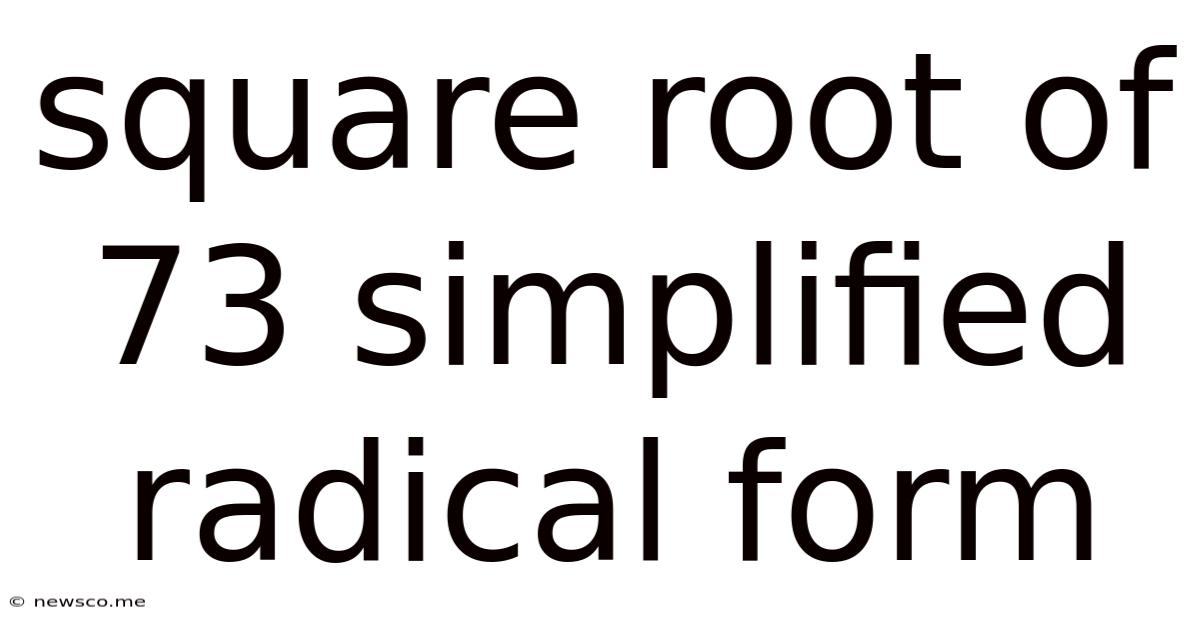Square Root Of 73 Simplified Radical Form
News Co
Apr 13, 2025 · 4 min read

Table of Contents
Simplifying the Square Root of 73: A Deep Dive into Radical Form
The square root of 73, denoted as √73, is an irrational number. This means it cannot be expressed as a simple fraction and its decimal representation goes on forever without repeating. While we can't simplify it to a whole number or a neat fraction, we can explore how to express √73 in its simplest radical form and understand the mathematical concepts behind it. This article will delve into the process of simplifying radicals, focusing specifically on √73, and also explore related concepts and applications.
Understanding Radicals and Simplification
Before we tackle √73, let's establish a foundational understanding of radicals and their simplification. A radical expression is an expression containing a radical symbol (√), indicating a root (usually a square root, but can also be cube roots, fourth roots, etc.). The number inside the radical symbol is called the radicand.
Simplifying a radical involves:
-
Finding perfect square factors: We look for factors of the radicand that are perfect squares (numbers that are the squares of integers, like 4, 9, 16, 25, etc.).
-
Extracting perfect squares: Once we find a perfect square factor, we can take its square root and move it outside the radical symbol.
-
Leaving non-perfect squares inside: Any factors that are not perfect squares remain inside the radical.
Example: Simplify √12
-
Find perfect square factors: 12 = 4 x 3, and 4 is a perfect square (2² = 4).
-
Extract the perfect square: √12 = √(4 x 3) = √4 x √3 = 2√3
-
The simplified form is 2√3.
Why √73 Cannot Be Simplified Further
Now, let's turn our attention to √73. The prime factorization of 73 is simply 73. It's a prime number, meaning it's only divisible by 1 and itself. Since 73 doesn't have any factors that are perfect squares (other than 1, which doesn't change the expression), it is already in its simplest radical form.
Therefore, √73 cannot be simplified further. There are no perfect square factors to extract. This means it remains as √73.
Approximating √73
Although we cannot simplify √73 algebraically, we can approximate its value using various methods:
-
Calculator: The easiest way is using a calculator. √73 ≈ 8.544
-
Babylonian Method (or Heron's Method): This iterative method allows for increasingly accurate approximations. Start with an initial guess (e.g., 8), then repeatedly apply the formula: x_(n+1) = ½ * (x_n + (N/x_n)), where N is the number you're finding the square root of (73 in this case) and x_n is your current approximation. Each iteration gets closer to the actual value.
-
Linear Approximation: Find the nearest perfect squares (64 = 8² and 81 = 9²). Since 73 is closer to 81, a rough approximation would be slightly less than 9.
While these methods provide approximations, it's important to remember that √73 is irrational; its decimal representation is non-terminating and non-repeating.
Applications of Radicals and Square Roots
Understanding radicals and square roots is fundamental in various areas of mathematics and beyond:
-
Geometry: Calculating the length of the diagonal of a square, the hypotenuse of a right-angled triangle (using the Pythagorean theorem), and the area of geometric figures often involve square roots.
-
Physics: Many physics formulas, particularly those dealing with motion, energy, and waves, involve square roots.
-
Engineering: In structural engineering, calculating stresses and strains requires the use of square roots.
-
Finance: Compound interest calculations and financial modeling often incorporate square roots.
-
Computer Graphics: Square roots are crucial in 3D graphics for calculations related to distances, rotations, and transformations.
Advanced Concepts Related to Radicals
-
Rationalizing the Denominator: When a radical expression has a radical in the denominator, it's often necessary to rationalize the denominator to make it easier to work with. This involves multiplying the numerator and denominator by a suitable expression to eliminate the radical from the denominator.
-
Operations with Radicals: Radicals can be added, subtracted, multiplied, and divided. However, only like radicals (radicals with the same radicand and index) can be added or subtracted directly.
-
Higher-Order Roots: Besides square roots (√), there are also cube roots (∛), fourth roots (∜), and so on. These are all generalizations of the radical concept.
-
Complex Numbers: The square root of a negative number is not a real number but a complex number, involving the imaginary unit i (where i² = -1).
Conclusion: The Importance of Understanding √73 and Radical Simplification
While √73 might seem like a simple, unassuming number, its exploration reveals a deeper understanding of radical expressions, their simplification, and their application across numerous fields. The fact that it cannot be simplified beyond its simplest radical form highlights the nature of irrational numbers and the limitations of representing them with finite decimal values. Mastering the concepts discussed in this article—from basic radical simplification to more advanced topics—is crucial for success in various mathematical and scientific disciplines. The seemingly simple act of simplifying radicals lays the groundwork for a much broader mathematical understanding and problem-solving abilities. By grasping the core principles, you equip yourself with powerful tools for tackling complex problems in a variety of contexts.
Latest Posts
Related Post
Thank you for visiting our website which covers about Square Root Of 73 Simplified Radical Form . We hope the information provided has been useful to you. Feel free to contact us if you have any questions or need further assistance. See you next time and don't miss to bookmark.